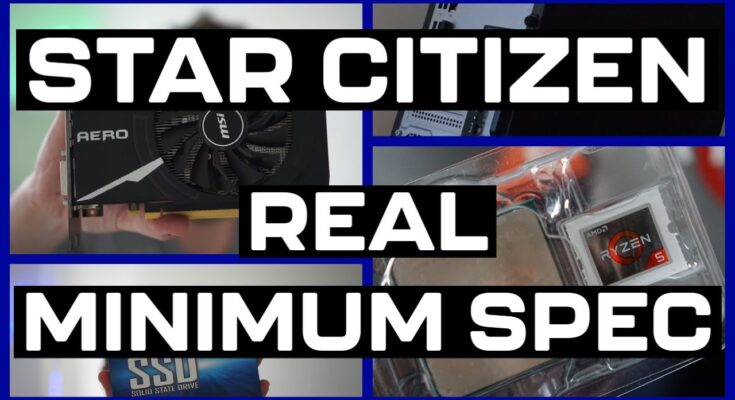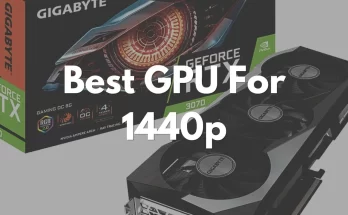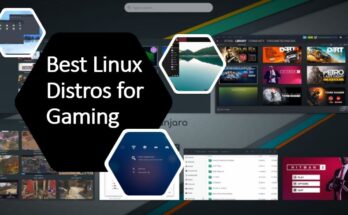If you’ve been keeping an eye on Star Citizen, you already know it’s one of the most ambitious games ever built — but also one of the most demanding. Many players search for the Star Citizen minimum specs to see if their current PC can handle the massive universe without stuttering or crashing. With large-scale environments, high-fidelity visuals, and constant online updates, knowing the system requirements is essential before downloading the client.
Star Citizen isn’t your average space sim. It’s a living, breathing galaxy designed for thousands of players at once, which means even modern rigs can struggle if not properly equipped. Unlike other games where you can slide a few settings down and get by, here your CPU, GPU, and storage speed all matter.
In this guide, we’ll break down the official Star Citizen minimum requirements and the recommended specs you’ll need for a smooth experience.
Official Minimum System Requirements for Star Citizen (2025)
Summary: A clear comparison of minimum vs. recommended hardware to get into the Verse with confidence.
Spec Comparison Table
| Specification | Minimum Requirements* | Recommended Specifications* |
|---|---|---|
| Operating System | Windows 10 (64-bit, latest service pack) | Windows 10 / Windows 11 (64-bit |
| Processor (CPU) | Quad-core — Intel i7 or later / AMD Bulldozer or later | Quad/Eight-core — Intel i7 or Ryzen-5 class or better |
| Memory (RAM) | 16 GB | 32 GB+ DDR4 |
| Graphics Card (GPU) | DirectX 11 compatible GPU with 4 GB VRAM | DirectX 12 compatible GPU with 8 GB+ VRAM |
| Storage | SSD with 100 GB+ free space | SSD (100 GB+), preferably NVMe for best experience |
What These Specs Mean
Minimum: You’ll be able to launch the game and explore, but you may encounter frame dips and reduced visual fidelity.
Recommended: A setup more likely to offer smoother gameplay, fewer stutters, and fluid performance in larger environments.
Important note: The game is still under development — specs may change as optimisation continues.
Before You Download
Confirm your GPU has at least 4 GB of VRAM — many older cards struggle below that.
Make sure your system uses an SSD, not a mechanical HDD — loading and performance suffer if not.
Have 16 GB RAM as the base — but 32 GB is becoming the practical baseline.
Meet the minimum? Good. Want smooth performance? Aim for the recommended side of the table.
Breaking Down Each Component: What to Know
Meeting the Star Citizen minimum specs on paper is one thing — understanding how each part of your hardware affects gameplay is another. Here’s what every key component actually does for your experience inside the Verse.
CPU (Processor)
Star Citizen relies heavily on your CPU for world simulation, AI control, and physics. While many games depend more on the GPU, this one is different — it’s CPU-intensive and needs solid single-core performance.
Minimum: Intel Core i7-6700 / AMD Ryzen 5 1600
Recommended: Intel Core i7-12700K / AMD Ryzen 7 5800X
💡 Tip: Even though Star Citizen uses multiple threads, most of the workload still runs on a few cores. A newer CPU with higher clock speeds and AVX support performs far better than an older high-core model.
GPU (Graphics Card)
The GPU handles rendering Star Citizen’s massive planets, ships, and lighting. It’s the most demanding part of your setup.
Minimum: NVIDIA GTX 1060 (4 GB) / AMD Radeon RX 580
Recommended: NVIDIA RTX 3060 (8 GB+) / AMD Radeon RX 6700 XT
If your GPU only meets the minimum, expect to run the game at 1080p on low settings. With a modern GPU, you’ll get smoother visuals and fewer texture pop-ins. VRAM capacity (video memory) is critical here — aim for at least 8 GB if possible.
💡 Tip: Avoid enabling ray tracing or ultra texture packs; they’ll destroy frame rates even on mid-range cards.
RAM (Memory)
Star Citizen is infamous for its memory usage. The game often consumes more than 16 GB during flight or city exploration.
Minimum: 16 GB DDR4
Recommended: 32 GB DDR4 or DDR5
If your system only has 16 GB, close all background apps before launching the game. Otherwise, the system may start swapping to your drive, causing long pauses or stutters.
💡 Tip: Dual-channel RAM (two sticks) improves bandwidth and can slightly reduce frame dips.
Storage (SSD vs HDD)
Forget HDDs — Star Citizen doesn’t just recommend an SSD; it requires one. The game’s streaming data structure loads planets and ships in real time, and HDDs can’t keep up.
Minimum: SATA SSD (100 GB free)
Recommended: NVMe SSD for faster asset loading and fewer texture delays
💡 Tip: Keep at least 20 GB of free space beyond the install size; the game uses that space for patching and data caching.
Cooling & Power Supply
Because Star Citizen pushes hardware hard, proper cooling and a reliable PSU are vital. Long sessions can heat up both GPU and CPU.
Use aftermarket coolers or extra case fans to maintain stable temps.
Avoid running on aging PSUs that can’t sustain full load; aim for 80 Plus Bronze or higher.
💡 Tip: Keep your GPU under 80 °C and CPU under 85 °C during long sessions to avoid performance throttling.
Every part of your PC matters for this game — not just your GPU. Balanced hardware ensures smoother gameplay, faster loading, and fewer crashes, especially as Star Citizen continues to grow in scale and complexity.
Will My PC Run Star Citizen? Quick Checklist
Not sure if your setup can handle it? Use this simple checklist to see if your PC meets the Star Citizen minimum specs and where it might fall short. You don’t need to be a hardware expert — just compare your parts against the list below.
Step 1: Check Your System Specs
You can quickly view your PC’s specs using built-in Windows tools:
Press Windows + R, type dxdiag, and press Enter.
→ You’ll see your CPU, GPU, and RAM listed.Or open Task Manager → Performance tab to check memory and graphics usage.
💡 Tip: Write down your processor model, GPU name, RAM size, and storage type (SSD or HDD)
Step 2: Compare Against Star Citizen Requirements
| Component | Minimum Spec | Recommended Spec | Your System |
|---|---|---|---|
| CPU | Intel i7-6700 / Ryzen 5 1600 | i7-12700K / Ryzen 7 5800X | ☐ |
| GPU | GTX 1060 (4 GB) / RX 580 | RTX 3060 / RX 6700 XT (8 GB +) | ☐ |
| RAM | 16 GB | 32 GB + | ☐ |
| Storage | SSD (100 GB free) | NVMe SSD (150 GB free) | ☐ |
| OS | Windows 10 64-bit | Windows 10/11 64-bit | ☐ |
If two or more boxes in your system column fall below the minimum — especially RAM or storage — expect stutters or long loading screens.
Step 3: Identify the Bottleneck
If your system struggles, note which part is weakest:
Low FPS or freezes: Your CPU may be maxing out.
Texture or asset delays: Upgrade to an SSD or NVMe.
Crash after long sessions: Insufficient RAM.
GPU pegged at 100% constantly: Lower resolution or settings like shadows and reflections.
Use this info to prioritise upgrades — small changes (like moving to an SSD or adding 16 GB RAM) can make a big difference.
Step 4: Quick Optimisation Tips
Close browsers and background apps before launching Star Citizen.
Run the game on High Performance mode (Windows → Power Options).
Keep your GPU drivers updated (NVIDIA / AMD official sites).
Avoid running the game from an HDD — use an SSD for faster streaming.
Step 5: Benchmark & Adjust
Once in game, press ~ (tilde) → type r_displayinfo 3 to view your FPS and performance stats. Test in different environments — landing zones, space, and combat — to gauge stability.
💡 Goal:
Above 30 FPS = Playable experience
45-60 FPS = Smooth performance
60+ FPS = Excellent optimisation and headroom for future updates
With this checklist, you’ll know whether your hardware is ready for lift-off or if a few upgrades are needed to truly enjoy the Verse.
Conclusion
Star Citizen is one of the most technically ambitious games ever made — and that comes with steep hardware demands. Meeting the Star Citizen minimum specs is enough to start exploring the Verse, but smooth gameplay requires more than just meeting the checklist.
With at least 16 GB of RAM, an SSD, and a modern quad-core processor, you’ll be able to launch and play. However, upgrading to 32 GB of RAM, a faster NVMe drive, and a newer GPU like the RTX 3060 or RX 6700 XT takes the experience to a whole new level.
The game’s development is still ongoing, and performance continues to improve with each update. So if your PC barely makes the cut today, you may find future versions running better than expected. Until then, tweak your settings, keep drivers updated, and fly smart — the Verse rewards both skill and patience.
Frequently Asked Questions (FAQ)
1. What are the Star Citizen minimum specs?
The minimum specs for Star Citizen include a quad-core CPU (Intel i7 or Ryzen 5 1600), 16 GB RAM, DirectX 11 GPU with 4 GB VRAM (GTX 1060 / RX 580), SSD storage, and Windows 10 64-bit.
2. What are the recommended specs for Star Citizen?
The recommended specs include a modern multi-core CPU (Intel i7-12700K / Ryzen 7 5800X), 32 GB RAM, DirectX 12 GPU with 8 GB VRAM (RTX 3060 / RX 6700 XT), and a fast NVMe SSD.
3. Can I run Star Citizen with 16 GB RAM?
Yes, but 16 GB is the absolute minimum. Players often report smoother performance with 32 GB, especially in busy cities or multiplayer areas.
4. Why does Star Citizen need so much RAM?
Because Star Citizen’s world is massive and persistent, it keeps many assets in memory for faster transitions between locations. As a result, the game can easily use 30 GB or more of RAM during gameplay.




